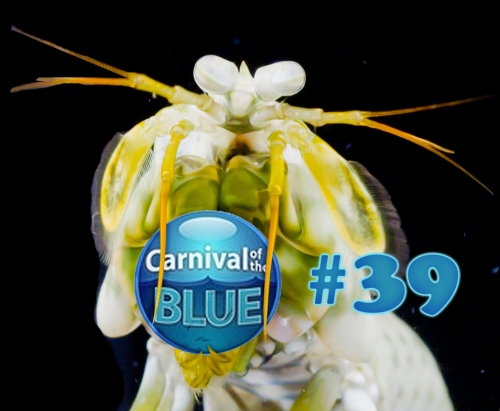I am moving my blog off of wordpress.com and joining the Southern Fried Science blog network. Arthropoda can now be found here. Please update your blogrolls and RSS feeds for my new address. I hope to see you all at my new home.
Mr. T pities the fools who haven’t updated their RSS feeds!
Published September 20, 2010 Administrative 5 Comments
There are still quite a few people who have not updated their RSS feeds for Arthropoda’s new RSS address. Get with the program, slackers! 
See all of my posts on arthropod cryptozoology, creationism, and pseudoscience for the Ocean of Pseudoscience blog event at Arthropoda’s new home.

See the photos at Arthropoda’s new home. 
Do scarab beetles get to join an exclusive visual sensory club?
Published August 27, 2010 Uncategorized Leave a CommentAnimal visual systems are evolutionarily tuned to exploit environmental light towards the purposes of spatial perception, navigation, and intraspecific communication. We predominately experience visual information based on variations in the intensity and the wavelengths of incoming light; perceived as brightness and colors. Other animals however, especially the arthropods, also rely on an additional visual modality with which to perceive their world. They are capable of detecting and discriminating different polarizations of light waves.
I’ve previously discussed how most arthropods detect linearly polarized light (LPL), and last week I summarized the research making mantis shrimp the first animal known to be capable of detecting and discriminating an additional flavor of polarized light, circularly polarized light (CPL). Now, new research has brought a challenger, a jewel scarab beetle (Chrysina gloriosa), into contention for the exclusive CPL sensitivity club. Lets find out how strong the beetle’s case is, and weather the mantis shrimp is going to have to share (begrudgingly, I’m sure) the spotlight.
Read the rest of this post at Arthropoda’s new home, on the Southern Fried Science Network.

Arthropod Roundup: Trilobites (both fossilized and stuffed), velvet worms, animated stomatopods, and deviant water striders
Published August 17, 2010 Uncategorized Leave a CommentSee this week’s roundup at Arthropoda’s new home on the Southern Fried Science Network. 
See the photo at Arthropoda’s new home on the Southern Fried Science Network. 
Mantis shrimp have long been regarded as visual super-stars. They can have up to 16 distinct photoreceptor types that are maximally sensitive to at least 12 different wavelengths (colors) of light; from deep in the ultraviolet, across our visual range, and into the infrared. In addition, they are strongly sensitive to linearly polarized light (LPL) and are able to discriminate the angle at which these waves of light are oscillating as they travel through space. This visual modality, though hugely foreign to us, is actually well perceived by cephalopods, some chordates, and almost universally amongst the arthropods. Mantis shrimp however, seemingly never content to be matched, have taken polarization sensitivity a step beyond any other animal. They have evolved an ingenious means of detecting and discriminating circularly polarized light (CPL)…
Read more at Arthropoda’s new home, on the Southern Fried Science Network. 
Salamanca
Published August 5, 2010 Administrative 1 CommentTags: Conference, ISN, Salamanca, Spain, Travel
In case you where wondering about the current lack of updates here; I am presently at the International Congress of Neuroethology in Salamanca, Spain. The city is absolutely beautiful and the conference so far has been jam packed with awesome science. It is giving me a lot of inspiration for my work and future articles on this site. I’ll be back to posting normally next Monday.

It is my pleasure to host this month’s edition of the Carnival of the Blue. I absolutely love the ocean, and I am impressed with how well my fellow bloggers are able to convey their own genuine sense of maritime wonder through writing. Without further ado, let’s put on our mask and fins and dive headlong into the best of July’s ocean blogging…
 Mike Lisieski has a great review about Cephalopod polarization vision on his new-ish, but awesome, blog: Cephalove. I feel a little dirty linking to something about Cephs other than videos of them getting demolished by mantis shrimp.
Mike Lisieski has a great review about Cephalopod polarization vision on his new-ish, but awesome, blog: Cephalove. I feel a little dirty linking to something about Cephs other than videos of them getting demolished by mantis shrimp.
 John at A DC Birding Blog, brings us a post about a research program tracking a beach-nesting shorebird, the Piping Plover. Bonus: Adorable Plover chicks.
John at A DC Birding Blog, brings us a post about a research program tracking a beach-nesting shorebird, the Piping Plover. Bonus: Adorable Plover chicks.
 David Shiffman (WhySharksMatter) at Southern Fried Science celebrates the 4th of July with a great post about the early history of marine biology in the US of A. Pioneering American naturalists Agassiz and Bache support the strong correlation between awesome facial hair and awesome science.
David Shiffman (WhySharksMatter) at Southern Fried Science celebrates the 4th of July with a great post about the early history of marine biology in the US of A. Pioneering American naturalists Agassiz and Bache support the strong correlation between awesome facial hair and awesome science.
 Speaking of great facial hair, Dr. M at Deep Sea News brings us an article about a fish that can rock one mean stache. Unsurprisingly, the lady-fish are helpless to resist the allure of such refined, unadulterated manliness – err fishliness.
Speaking of great facial hair, Dr. M at Deep Sea News brings us an article about a fish that can rock one mean stache. Unsurprisingly, the lady-fish are helpless to resist the allure of such refined, unadulterated manliness – err fishliness.
 Kevin Z, also at Deep Sea News, injects some science into a news story about a Lions Mane Jellyfish that broke up and stung 100 different people on a New Hampshire beach: Thus becoming the single most exciting event in the state’s history.
Kevin Z, also at Deep Sea News, injects some science into a news story about a Lions Mane Jellyfish that broke up and stung 100 different people on a New Hampshire beach: Thus becoming the single most exciting event in the state’s history.
 Zen Faulkes at NeuroDojo reports on some sloppy popular science fear mongering and lazy taxonomy surrounding a recent study about the effects of various drugs on an Amphipod Crustacean.
Zen Faulkes at NeuroDojo reports on some sloppy popular science fear mongering and lazy taxonomy surrounding a recent study about the effects of various drugs on an Amphipod Crustacean.
 Chuck at Ya Like Dags? raises a series of questions about fishery management and the dogfish and skate populations in Georges Bank, a crucial American fishery. Could population increases be the result of invading Canucks?
Chuck at Ya Like Dags? raises a series of questions about fishery management and the dogfish and skate populations in Georges Bank, a crucial American fishery. Could population increases be the result of invading Canucks?
 Here is a second contribution from David Shiffman; read this article before you start feeling too warm and fuzzy about dolphin-safe tuna. Find out about the monumental hidden costs of keeping non-endangered dolphins out of tuna nets.
Here is a second contribution from David Shiffman; read this article before you start feeling too warm and fuzzy about dolphin-safe tuna. Find out about the monumental hidden costs of keeping non-endangered dolphins out of tuna nets.
 Angelo Villagomez at Saipan Blog takes us on a guided tour of the Smithsonian’s offsite collections warehouse in Silver Springs (a true naturalist’s Mecca). He finds that it differs considerably from Dan Brown’s depiction of the facility in his novel, The Lost Symbol.
Angelo Villagomez at Saipan Blog takes us on a guided tour of the Smithsonian’s offsite collections warehouse in Silver Springs (a true naturalist’s Mecca). He finds that it differs considerably from Dan Brown’s depiction of the facility in his novel, The Lost Symbol.
 Speaking of the Smithsonian, here is the first ever Carnival of the Blue submission from their new Ocean Portal Blog. Christine Hoekenga sees though popular misconceptions, and tells us why sharks should be revered rather than feared.
Speaking of the Smithsonian, here is the first ever Carnival of the Blue submission from their new Ocean Portal Blog. Christine Hoekenga sees though popular misconceptions, and tells us why sharks should be revered rather than feared.
 Susannah, at the Wanderin’ Weta Blog visits Canada’s Crescent Beach to brave the Molluscan hordes. Don’t panic, and remember to bring a towel so you can clean up after the snail orgies and parasitic flatworms.
Susannah, at the Wanderin’ Weta Blog visits Canada’s Crescent Beach to brave the Molluscan hordes. Don’t panic, and remember to bring a towel so you can clean up after the snail orgies and parasitic flatworms.
 Hannah Waters at Culturing Science contributes an excellent article about dimethylsulfide (DMS). She uses awesome hand drawn figures to illustrate this inconspicuous compound’s integral entanglement with ocean ecology.
Hannah Waters at Culturing Science contributes an excellent article about dimethylsulfide (DMS). She uses awesome hand drawn figures to illustrate this inconspicuous compound’s integral entanglement with ocean ecology.
 Al at Deep Type Flow goes for a swim with a Whale Shark, and shares with us the feeling of pure wonder that he experiences. His dance with a giant highlights the sense of awe that grounds so many of us in marine science.
Al at Deep Type Flow goes for a swim with a Whale Shark, and shares with us the feeling of pure wonder that he experiences. His dance with a giant highlights the sense of awe that grounds so many of us in marine science.
 Finally, you can check out some photos and videos I took of two species of mantis shrimp: Gonodactylus platysoma and Gonodactylus chiragra. I am especially proud of the slow-motion video of G. chiragra striking the wall and knocking himself across the tank.
Finally, you can check out some photos and videos I took of two species of mantis shrimp: Gonodactylus platysoma and Gonodactylus chiragra. I am especially proud of the slow-motion video of G. chiragra striking the wall and knocking himself across the tank.
The next edition of the Carnival of the Blue will be hosted by Angelo at the Saipan Blog. The theme for his carnival will be ‘Carnival of the Blue XL: Top of the Food Chain Edition’, and he is looking for posts about predation, especially by sharks. Start submitting your great ocean blogging to the Carnival of the Blue automatic submission form.
Thank’s once more for allowing me to host this great carnival. I hope to see you all again soon, out in the Wild Blue.


















